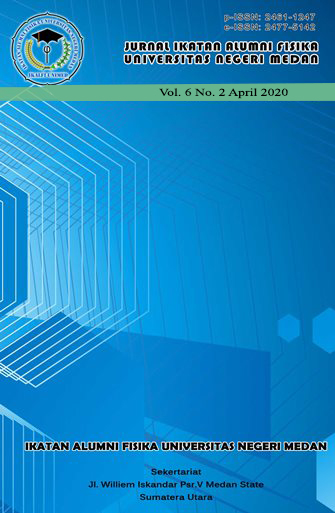IMPLEMENTASI BUKU AJAR BERBASIS MODEL PLAY-THINK-PAIR-SHARE (PTPS) UNTUK MENINGKATKAN PEMAHAMAN SISWA PADA MATERI MAGNET DI SDN 20 NAN SABARIS
DOI:
https://doi.org/10.24114/jiaf.v6i2.16398Keywords:
Textbooks, Learning Models, Play-Think-Pair-Share, Magnets, Elementary SchoolAbstract
This research is motivated by the students' low understanding of magnetic material in science learning in SDN 20 Nan Sabaris. The purpose of this study was to look at the effect of the use of PTPS models based textbooks on student understanding of magnetic material in SDN 20 Nan Sabaris. This type of research is a quasi-experimental study with a sample of all sixth grade students of SDN 20 Nan Sabaris registered in the 2019/2020 school year. Data collection instruments in this study used a written test and the data analysis technique used was the paired sample t-test. Based on the results of data analysis, it can be concluded that there are significant differences in student understanding between students learning to use teaching materials based on the PTPS model and conventional learning.References
Afdal. (2017). Peningkatan Hasil Belajar Ipa Tentang Gaya Magnet Melalui Model Pembelajaran Komperatif Tipe Stad Pada Siswa Kelas Va Sdn 010 Bayur Samarinda Utara. Jurnal Pendas Mahakam, 2(1), 1-13.
Alexopoulos, M Pavlidou and S. Cherouvis. (2019). ˜Playing with Protons™: a training course for primary school teachers at CERN. Physics Education, 54, 1-13.
Bagnoli, Franco, Alessio Guarino and Giovanna Pacini. (2018). Teaching Physics By Magic. 54, 1-15.
David, Herrero, Héctor del Castillo, Natalia Monjelat, Ana Belén GarcÃa-Varela, Mirian Checa & Patricia Gómez. (2014). Evolution and natural selection: learning by playing and reflecting. New approaches in educational research, 3 (1), 26“33. Doi: 10.7821/naer.3.1.26-33
Dwiana, Elly Hendrawati. (2018). Penggunaan Media Permainan dalam Pembelajaran Matematika untuk Pengembangan Karakter Siswa di SMP Negeri 24 Surakarta. Jurnal Administrasi Pendidikan: Universitas Muhammadiyah Surakarta, 1-12.
Ede, Yakobus Pawe, Chumdari & Hasan Mahfud. (2016). Peningkatan Pemahaman Konsep Gaya Magnet Melalui Model Pembelajaran Pbl (Problem Based Leraning) Pada Siswa Sekolah Dasar. Jurnal Didaktika Dwija Indria, 6-12.
Hui-Chun Chu, Shao-Chen Chang. (2017). Developing an educational computer game for migratory bird identiï¬cation based on a two-tier test approach. Education Tech Research Dev, 30-45. DOI 10.1007/s11423-013-9323-4.
Ifrianti, Syofnida. (2015). Implementasi Metode Bermain Dalam Meningkatkan Hasil Belajar Ips Di Madrasah Ibtidaiyah. Jurnal Pendidikan dan Pembelajaran Dasar, 2 (2), 150-169.
Ioannis Altanis, Symeon Retalis and Ourania Petropoulou. (2018). Systematic Design and Rapid Development of Motion-Based Touchless Games for Enhancing Students™ Thinking Skills. Education Science, 8 (18), 1-15. Doi:10.3390/educsci8010018
Jannine, Stephanie Sfrisi, Sandra Deemer, Deborah Tamakloe, & Ojoma Edeh Herr. (2017). The Investigation of the Learning Style Preferences and Academic Performance of Elementary Students with ADHD. The Excellence in Education Journal, 6 (2), 32-49.
Khasanah, Makhbubi., Harun Setyo Budi, & Kartika Chrysti. S. (2012). Penggunaan Metode Permainan Dalam Peningkatan Pembelajaran Pkn Siswa Kelas Iv Sd N 2 Jatimulyo, Kecamatan Petanahan, Tahun Ajaran 2011/2012. Jurnal FKIP UNS Surakarta, 1-6.
Laura Miralles, Paloma Moran, & Eduardo Dopico Eva Garcia-Vazquez. (2013). DNA Re-EvolutioN: A Game for Learning Molecular Genetics and Evolution. Biochemistry and Molecular Biology Education, 4(13), 396-401. DOI 10.1002/bmb.20734
López Carrillo, D. et al., (2019). Using Gamification in a Teaching Innovation Project at the University of Alcalá: A New Approach to Experimental Science Practices. The Electronic Journal of e-Learning, 17(2), pp. 93-106
Marleny Leasaa, Aloysius D. Corebimac, Ibrohimc, & Hadi Suwonoc. (2017). Emotional intelligence among auditory, reading, and kinesthetic learning styles of elementary school students in Ambon- Indonesia. International Electric Journal of Elementary Education. 10 (1), 83-91. DOI: 10.26822/iejee.2017131889.
Ming-Hsiu Mia Chen , Shih-Ting Tsai and Chi-Cheng Chang. (2019). Effects of Game-Based Instruction on the Results of Primary School Children Taking a Natural Science Course. Education Science, 9 (79), 1-15. doi:10.3390/educsci9020079
Misty Adoniou. (2016). Don™t let me forget the teacher I wanted to become, Teacher Development, 20(3), 348-363. DOI: 10.1080/13664530.2016.1149510
Nikmah, Sahibun. (2012). Penggunaan Metode Permainan Dalam Pembelajaran Ipa Untuk Meningkatkan Aktivitas Dan Hasil Belajar Siswa Kelas Iv Sekolah Dasar Negeri 11 Sungai Melayu Rayak. Jurnal Pendidikan Dasar, 5-14.
Sánchez-Rivas, E., Ruiz-Palmero, J., Sánchez-RodrÃguez, J. (2019). Gamification of Assessments in the Natural Sciences Subject of Primary Education. Educational Sciences: Theory & Practice, 19(1), 95-111. http://dx.doi.org/10.12738/estp.2019.1.0296
Scholl, R., Nichols, K., & Burgh, G. (2009). Philosophy for children: Towards pedagogical transformation. Refereed paper presented at ˜Teacher education crossing borders: Cultures, contexts, communities and curriculum™ the annual conference of the Australian Teacher Education Association (ATEA), Albury, 28 June “ 1 July.
Turkmen, Hakan & Elif Unver. (2018). Comparison of Elementary Students™ Images of Science Teaching for Turkish, Dutch, Scottish, and German Science Classrooms. 6(11): 2624-2633, DOI: 10.13189/ujer.2018.061127.
Zakirman, Z. (2019). Peningkatan Minat Baca Siswa Melalui Penerapan Model Pembelajaran Play-Think-Pair-Share Di SDN 19 Nan Sabaris. Shaut Al-Maktabah: Jurnal Perpustakaan, Arsip dan Dokumentasi, 11(1), 41-51.
Zakirman, Z. Z. (2017). Pengelompokkan Gaya Belajar Mahasiswa Menurut Teori Honey Mumford Berdasarkan Intensitas Kunjungan Pustaka. RISTEKDIK: Jurnal Bimbingan dan Konseling, 2(2).
Zakirman, Z., & Hidayati, H. (2017). Praktikalitas Media Video dan Animasi dalam Pembelajaran Fisika di SMP. Jurnal Ilmiah Pendidikan Fisika Al-Biruni, 6(1), 85-93. https://doi.org/10.24042/jpifalbiruni.v6i1.592
Downloads
Published
Issue
Section
License
Copyright (c) 2020 JURNAL IKATAN ALUMNI FISIKA UNIVERSITAS NEGERI MEDAN

This work is licensed under a Creative Commons Attribution 4.0 International License.
Authors who publish with this journal agree to the following terms:- Authors retain copyright and grant the journal right of first publication with the work simultaneously licensed under a Creative Commons Attribution License that allows others to share the work with an acknowledgement of the work's authorship and initial publication in this journal.
- Authors are able to enter into separate, additional contractual arrangements for the non-exclusive distribution of the journal's published version of the work (e.g., post it to an institutional repository or publish it in a book), with an acknowledgement of its initial publication in this journal.
- Authors are permitted and encouraged to post their work online (e.g., in institutional repositories or on their website) prior to and during the submission process, as it can lead to productive exchanges, as well as earlier and greater citation of published work (See The Effect of Open Access).

